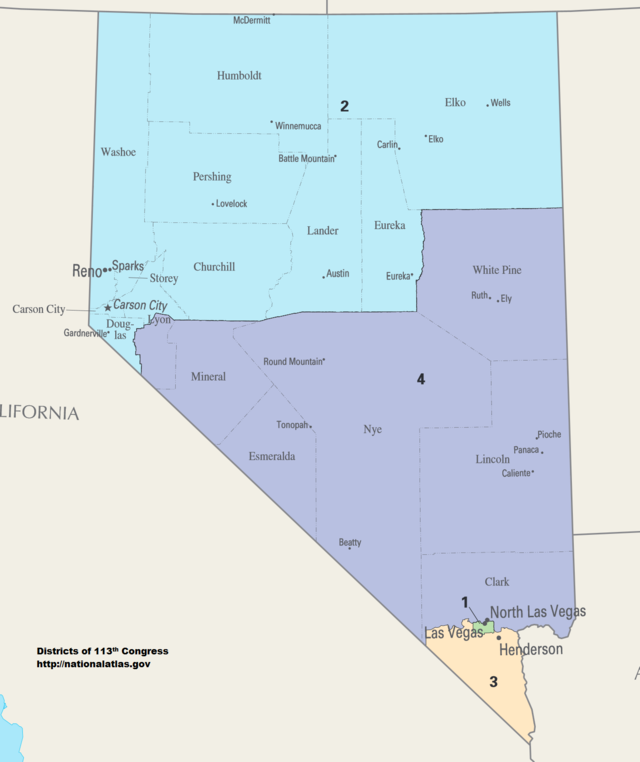OPINION: Don’t compare Fair Maps to the Almighty — compare them to the alternative

Every decade, politicians in Nevada attempt to decide who their voters will be. Sometimes they’re even successful.
Though this may sound like a somewhat unfair description of the state’s current redistricting process — the process through which legislative and congressional districts are redrawn following a census — it is a textually accurate description of the process as defined in the state Constitution. According to Article 4, Section 5, it is a “mandatory duty of the Legislature” following each census to decide how many legislators will serve and which geographical areas they’ll represent.
Beyond that, there are few limitations or restrictions on how that work is done.
Constitutionally, the Legislature can only have up to 75 members and the census must serve as the “basis of representation” for legislative redistricting. The 14th Amendment, meanwhile, requires state legislatures, including Nevada’s, to make an “honest and good faith” effort to ensure districts are constructed with roughly equal population. Additionally, the federal Voting Rights Act, which was written to enforce the 15th Amendment, prohibits redistricting plans that are shown to have a racially discriminatory result.
Drafting redistricting plans with politically discriminatory results, on the other hand, is entirely allowed — assuming, of course, that the Legislature can convince the governor to sign off on it. This gives us something in common with Florida, where former presidential candidate and current Gov. Ron DeSantis vetoed the maps presented to him by his state’s Republican-led legislature because they weren’t partisan enough for his liking.
This is, of course, not unusual. Gerrymandering — the process of redrawing political districts to benefit partisan political interests, sometimes with geometrically hilarious results — is nearly as old as this country.
When gerrymandering first started in the 18th century, however, mapmakers were working by hand and rule of thumb. Nowadays, political operatives almost have enough data and computational power to slice your home between multiple districts — your young Democratic-leaning adult child in the den in one district, your swingy nonpartisan master bedroom in another and the guest bathroom used by your Republican parents when they visit in yet another.
Consequently, only 40 congressional districts are highly competitive. Additionally, obvious partisan tilts such as Nevada’s 2nd Congressional District — no candidate has ever come within 15 percentage points of Rep. Mark Amodei (R-Carson City) in a general election — are considered merely “partisan-leaning,” as opposed to solidly partisan, because they’re still more competitive than the overwhelming majority of districts.
If it sounds like gerrymandering serves as an incumbency protection plan, that’s only partially true. When the government is divided — say, when the Senate is controlled by one party while the Assembly is controlled by the other, or the governor comes from one party while the other party controls the majority of the Legislature — some horse trading undeniably happens. When every organ of government responsible for redistricting is controlled by the same party, however, they can focus solely on maximizing partisan advantage.
That, incidentally, explains how a state that President Joseph R. Biden won with less than a 3 percentage point margin, a state that Sen. Catherine Cortez Masto won by less than a single percentage point and a state that elected three Republicans to statewide office has Democrats representing it in 75 percent of its congressional seats and 65 percent of its legislative seats. In 2021, following the release of the results of the 2020 census, a majority-Democratic Legislature worked with a Democratic governor to pass a set of maps that were favorable to Democrats.
Democrats, however, do not have a monopoly on gerrymandering — far from it. According to the Brennan Center for Justice, 41 percent of all congressional districts were drawn by Republican legislatures in 2022, while only 11 percent (including Nevada’s) were drawn by Democratic legislatures. Additionally, North Carolina, which used court-drawn maps for its 14 congressional seats in 2022, will now rely on Republican-drawn maps for the rest of the decade following the election of a more conservative state supreme court and extensive court challenges.
It’s undeniably true that, when drawing boundaries for winner-take-all electoral districts, a basis has to be selected to decide who’s likely to be represented and who’s not. Some voters in any given district will be in the majority and some will be in the minority — that’s life in our particular flavor of democracy (there are other flavors, but that’s a separate discussion). That basis could be race, class, communities of interest, geographical compactness, similarity with existing city and county lines or a million otherwise arbitrary criteria.
Lately, however, the only basis reliably considered is pure partisan advantage. That’s a problem if you, like me, are a nonpartisan voter — or you just think Americans have interests and traits beyond partisan identity that should be considered by our political system, especially at the state and local level.
To help ensure some criteria other than naked partisan advantage guides redistricting processes, many states are beginning to consider other methods. These methods, however, are producing mixed results.
As ProPublica recently covered, Washington state’s attempts at producing a fairer redistricting process through the use of an evenly divided bipartisan commission led to paralysis. With the benefit of hindsight, the supposedly independent commission wasn’t independent at all — its members were either former partisan lawmakers or lobbyists, so they were more accountable to partisan political pressures than they were to either Washington’s voters or the redistricting process.
Independent commissions staffed by citizens screened for conflicts of interest, such as working for a political party or being a lobbyist, meanwhile, aren’t doing much better. Michigan, one of the few states to use an independent commission, had its maps rejected by federal judges because the commission improperly relied on race to spread Black voters across several Black-minority districts in violation of the Voting Rights Act. That decision was recently supported by the U.S. Supreme Court.
Other states, meanwhile, rely on their judicial system to complete the redistricting process ad hoc, as Nevada did in 2011 after the state’s Democratic-majority Legislature and Republican governor failed to reach an agreement on their own. Though this does tend to produce fairer, less intrinsically partisan maps in the short run, it can also politicize the judicial branch — as it did in North Carolina.
Even so, hope springs eternal among those who would like to see something done about the otherwise purely partisan process used to draw electoral districts, even if no alternative provides perfect results. After all, maps drawn solely to advance partisan advantage aren’t always acceptable, either — that’s why they sometimes get thrown out by courts in the first place.
Within that glimmer of hope lies the Fair Maps petitions, which both seek to replace Nevada’s partisan redistricting process with one run by an independent commission. If either of them are passed (one petition starts the redistricting process sooner than the other), the measure will create a seven-member commission, of whom four will be selected by partisan legislators. Those four commissioners, in turn, would then select three additional commissioners — however, the four commissioners would not be allowed to select anyone who had been registered with either major party in the past four years.
Anyone who worked as a lobbyist, filed for partisan public office or worked for a political party or political action committee within the last four years would be prohibited from serving as a commissioner. Additionally, anyone who worked for the legislative or executive branch of the state government would also be prohibited from serving as a commissioner (employees of our state’s higher education system excepted).
The goal, at least in Nevada, is to recapture the spirit of 2011, when a group of independent court-appointed special masters redrew the electoral map to something Republicans and Democrats could both reluctantly tolerate. The resulting maps helped briefly lead to an evenly divided congressional delegation and a nearly evenly divided state Senate for several years, accurately reflecting how Nevada’s voters tend to be split more or less down the middle in every election.
Nevada is not the only state where organizers are attempting to pass measures like this. Similar efforts are also underway in Texas, Florida, North Carolina and Ohio.
Should you support either petition? That depends on who you are.
If you’re a Republican, you’d likely have no reservations supporting the Fair Maps petitions. In the past 100 years, Republicans enjoyed majorities in both houses of the Legislature in only three biennia: 1925, 1929 and 2015. Though Republicans have had considerably more success electing their own to the governor’s mansion, governors can only approve or veto maps. They don’t have the legal authority to draw their own. Consequently, unless Republicans start succeeding at something they’ve historically struggled with — namely, selecting electable legislators — Republicans will always be on the outside looking in when districts are drawn by partisan elected officials in this state.
If you’re a Democrat in Nevada, however, you’d probably prefer to see the petitions die in a courtroom. If states such as Texas, Florida and North Carolina pass their own Fair Maps initiatives or legislation, perhaps Democrats in Nevada can afford the luxury of de-escalation. Until then, the petitions, if enacted, would disarm the party against a clearly hostile force in one of the few states where Democrats sometimes — not always, but sometimes — have the ability to draw their own maps.
However if, like me, you’re a nonpartisan voter, the decision to support or oppose the petitions isn’t quite as cut and dry.
No, I certainly don’t want to give Democrats a blank check to choose their own voters in my state. When one party is able to secure a comfortable advantage and the opposing party can be safely ignored, state and local issues get resolved in obscure intraparty squabbles during low-turnout primaries. Competing visions of change never get a chance to be evaluated and accepted by the majority of voters in the general election.
Politicians receiving donations and high paying jobs after voting in favor of specific lobbying groups can only be explained as the product of laziness bred by a lack of serious competition. In a state where divided government was the norm instead of an increasingly infrequent exception, lobbying groups themselves would self-police their behavior to avoid damaging the political prospects of their causes. In a state where there’s little meaningful competition, on the other hand, lobbying groups can flex their muscles with impunity because they know they — and their pet politicians — can get away with it.
That said, Nevada’s small congressional delegation represents the state in a body where a substantial plurality of their colleagues are selected using maps drawn by unapologetic Republican Party operatives for obvious partisan advantage. Though the Democratic Party undeniably enjoys that same luxury in Nevada, it’s considerably rarer since many Democratic-leaning states use independent or bipartisan commissions, instead of partisan legislative majorities, to draw political districts.
None of that means we should give up or accept either party maintaining sole control over our electoral maps. It does, however, mean we all need to be a little strategic about our support.
Sign both petitions if they’re presented to you. Vote in favor of whichever Fair Maps petition makes it to the ballot the first time it shows up on your ballot.
Before you vote in favor of it a second time, however, make sure a few Republican-leaning states pass their Fair Maps initiatives, too.
David Colborne ran for public office twice. He is now an IT manager, the father of two sons, and a weekly opinion columnist for The Nevada Independent. You can follow him on Mastodon @[email protected], on Bluesky @davidcolborne.bsky.social, on Threads @davidcolbornenv or email him at [email protected].
